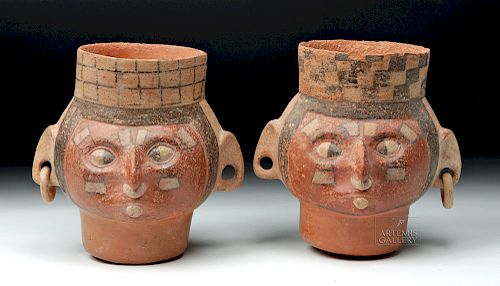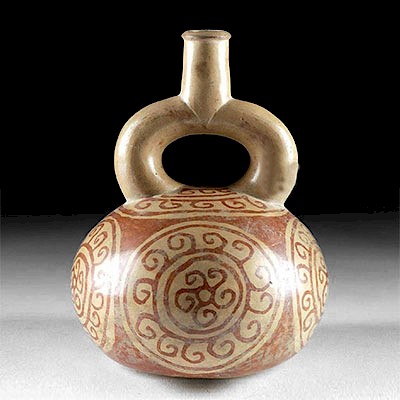Pair Tihuanaco Pottery Figural Jars w/ TL
Lot 63a
About Seller
Artemis Fine Arts
686 S Taylor Ave, Ste 106
Louisville, CO 80027
United States
Selling antiquities, ancient and ethnographic art online since 1993, Artemis Gallery specializes in Classical Antiquities (Egyptian, Greek, Roman, Near Eastern), Asian, Pre-Columbian, African / Tribal / Oceanographic art. Our extensive inventory includes pottery, stone, metal, wood, glass and textil...Read more
Estimate:
$3,000 - $4,500
Absentee vs Live bid
Two ways to bid:
- Leave a max absentee bid and the platform will bid on your behalf up to your maximum bid during the live auction.
- Bid live during the auction and your bids will be submitted real-time to the auctioneer.
Bid Increments
| Price | Bid Increment |
|---|---|
| $0 | $25 |
| $300 | $50 |
| $1,000 | $100 |
| $2,000 | $250 |
| $5,000 | $500 |
| $10,000 | $1,000 |
| $20,000 | $2,500 |
| $50,000 | $5,000 |
| $100,000 | $10,000 |
| $200,000 | $20,000 |
About Auction
By Artemis Fine Arts
Jan 24, 2019
Set Reminder
2019-01-24 10:00:00
2019-01-24 10:00:00
America/New_York
Bidsquare
Bidsquare : Pre-Columbian / Ethnographic Art
https://www.bidsquare.com/auctions/artemis-gallery/pre-columbian-ethnographic-art-3814
Featuring ancient and ethnographic art from around the world, including Pre-Columbian, Native American, African / Tribal, Ethnographic, Spanish Colonial, Fossils, Fine Art, much more. Artemis Fine Arts info@artemisfinearts.com
Featuring ancient and ethnographic art from around the world, including Pre-Columbian, Native American, African / Tribal, Ethnographic, Spanish Colonial, Fossils, Fine Art, much more. Artemis Fine Arts info@artemisfinearts.com
- Lot Description
Pre-Columbian, Bolivia, South Andean highlands, Lake Titikaka region, Tihuanaco / Tiwanaku ca. 400 to 800 CE. A very unusual pair of polychrome terracotta head vessels presenting matching visages comprised of crossed-eyes (a trait characteristic of coastal Tiwanaku visual culture), protruding noses adorned by noserings delineated in relief, closed lips with labrets also in relief, wonderful tattoos or face paint decorations surrounding their eyes, black coiffures, tall headdresses (which also serve as the vessels' necks) embellished with lively checkerboard patterns - one black and white and the other all white but outlined in black, and pierced ears - one on each figure fitted with a terracotta hoop earring. Size: each vessel measures ~ 7.75" W x 7.75" H (19.7 cm x 19.7 cm)
The practice of taking trophy heads was a very important religious/political act for the Tiwanaku/Tihuanaco and Wari/Huari peoples. The Tiwanaku used trophy heads to decorate the walls of public buildings. In addition, artisans created trophy head drinking vessels. We know that the later Inca would use captured enemy warrior's skulls to create libation vessels for ceremonies associated with victories and other political events. The idea was to emphasize the power of the user as well as the notion that the victor was appropriating the vanquished warrior's power. Scholars believe that the Tiwanaku and the Wari - who were ancestral to the Late Horizon Incas - held similar beliefs to those of the Inca. It is also possible that the act of trophy head-taking was about more than political domination. In ancient Peru, decapitation was also involved in a ritual associated with the harvest; the indigenous used human blood to fertilize mother earth (Pacha Mama). As an extension of this idea, the vanquished warrior symbolized a magical force used to revitalize the earth and promote balance in nature. In this sense, the warrior's spirit never died but rather lived on by contributing in this way.
This piece has been tested using thermoluminescence (TL) and has been found to be ancient and of the period stated. A full report will accompany purchase.
Provenance: private Tacoma Washington USA collection formed over 30 years ago; ex-private collection of Charles McGill, acquired in 1980s from Argosy Art & Artifacts in 1980s; ex-Wolf Mankowitz, Irish consul to Panama, acquired during a visit to Panama in 1972; This pair comes with a letter written to Dr. McGill from Bernard Brown of Argosy (11/7/88), a Guarantee of Authenticity from Agosy (10/5/88), and a note written by Wolf Mankowitz, Irish consul to Panama, stating that the pair was acquired from a "highly reputable dealer in Panama in 1972".
All items legal to buy/sell under U.S. Statute covering cultural patrimony Code 2600, CHAPTER 14, and are guaranteed to be as described or your money back.
A Certificate of Authenticity will accompany all winning bids.
We ship worldwide and handle all shipping in-house for your convenience.
#131421Expected surface wear with areas of normal abrasion/pitting, and slight losses to pigment, but the imagery is still quite vivid. A couple of minor repairs to the bases. Chips to rims as shown. Each one has one earring; assuming there was another, it is now lost. Fabulous manganese blooms inside the vessel with the black and white checkerboard headdress.Condition
- Shipping Info
-
All shipping is handled in-house for your convenience. Your invoice from Artemis Gallery will include shipping calculation instructions. If in doubt, please inquire BEFORE bidding for estimated shipping costs for individual items.
-
- Buyer's Premium



 EUR
EUR CAD
CAD AUD
AUD GBP
GBP MXN
MXN HKD
HKD CNY
CNY MYR
MYR SEK
SEK SGD
SGD CHF
CHF THB
THB


















